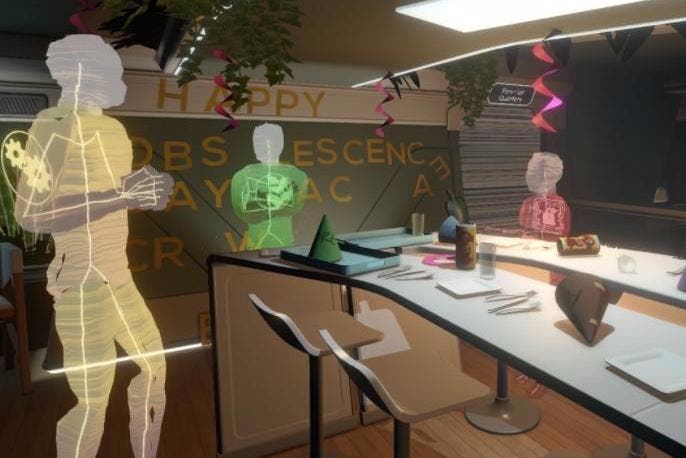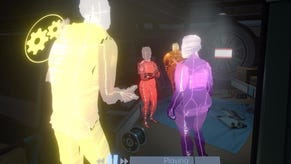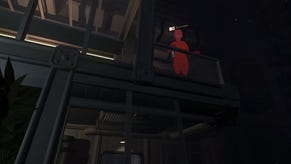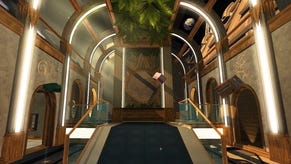Tacoma is like Gone Home, in space, with time-travel powers
Time is on my side.
Fullbright's debut title, the exploratory coming-of-age tale Gone Home, was quietly revolutionary. Founded by a trio of ex-BioShock 2 developers, Fullbright hypothesised that it could make a game like BioShock, only without combat or supernatural elements, and it would still be interesting. It was. While Gone Home wasn't everyone's cup of tea, it gained a cult following and was at the forefront of a new wave of games such as The Vanishing of Ethan Carter, Everybody's Gone to the Rapture, and Firewatch. How do you make another game in the same vein and keep it feeling fresh?
The answer is through time manipulation powers. Pausing, rewinding, and fast-forwarding time has been used far and wide as a game mechanic in titles such as Braid and Quantum Break as well as another recent high-profile game, but outside of a few experimental titles like Majora's Mask, Life is Strange and The Last Express, it's rarely been used as a meaningful storytelling device. Tacoma seeks to do for exploring time what Gone Home did for exploring space.
Here's how that works: in Tacoma you play as an engineer exploring the titular space station after its crew mysteriously disappeared. So far, so Gone Home. The catch is that you don't just look at props and hear the occasional audio diary narrating the main points of the plot: instead you encounter complex multi-character scenes that play out in real-time as you witness holographic recordings of the vanished crew's digital representations.
Purely on that level, it may sound similar to Everybody's Gone to the Rapture, with its shimmering ghosts re-enacting the final days of a dead world, but the twist here is that these ensemble scenes contain multiple conversations across several rooms. In order to hear them all, you'll have to pause and rewind these virtual recordings as you stalk the disparate figures going about their business.
If this reminds you of a production by theatre company Punchdrunk (Sleep No More, The Drowned Man), that's not a coincidence. Creative director Steve Gaynor credits the collective's interactive experiences as one of Fullbright's main influences. For those who've not had the pleasure of attending one of these productions, the gist is that the audience is free to explore a multi-room set on their own accord and occasionally a scripted scene will play out if you're in the right room at the right time. These scenes usually end with the cast splitting up in different directions while audience members decide which character they'd like to follow (or just be left to their own devices, Bethesda-style). Nobody can get close to seeing every scene in one attendance. As far as theatre goes, Punchdrunk has set a high bar for replay value.
Gaynor points out that these productions are actually set on a loop, so each show is three hours long, but it's really an hour-long cycle repeating itself three times. As such, an attendee could come across a couple having an argument and follow one character the first time, then the other character later. But you need to wait an hour to do this. The power of the single-player digital realm of video games is that you needn't wait for live actors to resume their scenes: you can simply rewind.
"We want you to pause and rewind and go somewhere else and examine it from another angle and be able to be in control of revisiting that stuff on your own schedule," Gaynor tells me at Fullbright's quaint Portland studio.

"It might sound froofy, but I kind of think of this as exploring a story in four dimensions," he adds. "You're sort of placing yourself in a physical space and watching characters in a physical space, but you're also controlling the timeline of what they're doing. So you're really thinking of yourself as 'where do I need to be at what time to see these other parts of what I'm trying to understand?"
Gaynor also notes that exploring the same moment from different perspectives is something that can only be done in a video game. "I think there's something really powerful in saying 'I'm a perspective, and the game's mechanic allows me to place that perspective on all these different points of the graph and kind of observe the entirety of something that in real-life we don't have the ability to do as individuals."
This time-based storytelling, coupled with the nifty sci-fi explanation that you can rewind since these are holographic recordings of real people, makes Tacoma more palatable to easily distracted players (such as myself) prone to missing details. As much as I admire titles like Gone Home and Dear Esther, there is a sense that if you miss an important line or gesture, you'll be lost trying to follow the labyrinthine breadcrumb trail of the plot. Generally speaking, you can only revisit such sections by playing through the whole game again, loading an old save file, or looking up clips on YouTube. All of these are a hassle.
But Tacoma's non-linear map and chronology means you can conveniently revisit these earlier scenes at any time. Indeed most mystery games like Everybody's Gone to the Rapture, BioShock Infinite, and The Vanishing of Ethan Carter pepper clues throughout the adventure that aren't meant to be understood until a subsequent playthrough. By allowing the player the ability to revisit and rewind each scene, one can conveniently flip through previous scenarios armed with greater sense of context regarding who these people are.
On this level, Tacoma seems to be more of a puzzle game than Gone Home. It doesn't appear to have typical logic puzzles, mind, but it's more of a puzzle the way Virginia is a puzzle game, where piecing together the story is the gameplay. Relative to Gone Home, Tacoma is more abstract and much harder to put one's finger on than Fullbright's painstakingly authentic representation of the rural outskirts of Portland, Oregon circa 1995. Figuring out even the basics of Tacoma takes much longer to wrap your head around. What was the crew up to? Where did they go? Did the eerily calm AI Odin do something terrible?
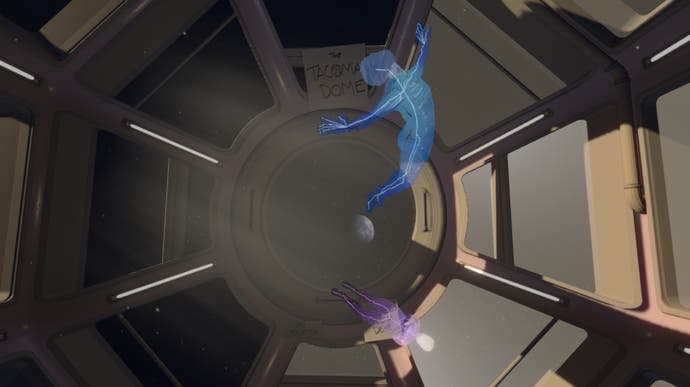
My one concern with Tacoma's fourth-dimensional interactivity is that scenes play out in relatively small spaces that threaten to limit the possibility of surprise. The demo has a section where six characters begin in a few different rooms until they all meet up for a party ("Obsolescence Day!") in the dining quarters midway through a two minute recording. It's much longer, of course, as you'll probably want to rewind and watch what everyone was up to in the scene's first half, but in the end rewinding and observing can feel like going through the motions when you know this whole ensemble sequence is limited to the timestamp on your HUD. It doesn't seem like you can just stumble into a room and find a secret scene playing out - the way some of Majora's Mask's more obscure content was hidden.
It was designed this way for a reason though, as the developer doesn't want Tacoma to be saddled with lots of waiting (as Majora's Mask and The Last Express were). "We didn't want any of our single scenes to be especially extended, or have a ton of downtime," Gaynor tells me. "On some level we're entering into a contract with the player that says 'all the stuff that you can find here is worth finding.' So we do want to pick moments that are focused, so you get something out of every moment. So there isn't going to be a scene that's an hour long. But hopefully what's interesting about that is the density of what is there."
That comes across in the 20-minute press demo. Each scene has characters actively engaged in dialogue or performing intriguing actions. One of the most tantalising moments includes a character's holographic recording stepping through door that's locked in the current timeline. As such, I could watch them through the window speaking to someone on their space phone, but I've no idea what they were saying. Ostensibly there will be a way to unlock this door so I can finally eavesdrop on them behind (literal) closed doors.
From my brief glimpse of Tacoma, its observing-to-exploring ratio is slanted far more heavily towards the former than Gone Home, but, like Her Story before it, observing in Tacoma is playing. Moving through time and space, gathering intel to formulate a mental map of this mystery, turns Tacoma into a detective game of sorts. And thanks to the advanced holographic surveillance tech, your trail will never go cold.
